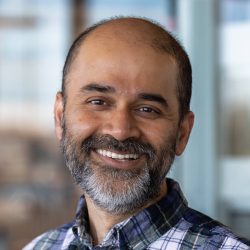
Vaibhav Pai is a Research Scientist in the Allen Discovery Center at Tufts University where he is currently engaged in using synthetic biology and bio-robots to explore first principles of morphology (information for shape formation and exploring possible morphologies outside evolutionary constraints), basal/non-neural somatic cell cognition, decision making, and computation with a focus on role of bioelectric circuits (ion fluxes and membrane voltage patterns within somatic cells).
His past research involved discovering serotonin autocrine-paracrine system in mammary glands and how it interfaces with biophysical mechanisms (Trans-epithelial resistance – a key component of epithelial function) in acting as a switch between lactation and involution (breakdown of milk producing machinery and total reconfiguration of gland). He also discovered how this serotonergic system gets hacked by breast cancers. This work had a major impact on mammary gland biology, breast cancer, and the dairy industry.
Vaibhav Pai is primarily interested in biophysical mechanisms guiding complex biological processes. Understanding how bioelectrical circuits (ion fluxes and membrane voltage patterns within somatic cells) control embryonic organ development, regeneration, and repair. His research combines novel biophysical approaches and state-of-art imaging (voltage-reporter dyes and optogenetics) with developmental biology, neurobiology, molecular biology, and computational approaches to discover the basic principles underlying bioelectric control of morphogenesis. This knowledge will give us the capability to use bioelectric manipulation for regeneration and repair in cases of birth-defects, traumatic injuries, diseases, and cancer (all of which can be seen as issues of loss of shape information). This knowledge will also help develop new pharmaceuticals (drugs targeting ion channels - ionoceuticals) and will have long term impact in bioengineering.